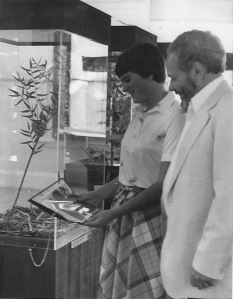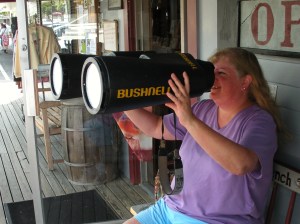Guest post by Kari Jo Spear, Photographer, Novelist, and Daughter of Bob Spear
This post appeared first in our Winter 2015 issue of Chip Notes.
In place of a regular Carver’s Daughter installment, I want to offer a few tidbits of information about my father that most people probably don’t know. Bear in mind that these are family stories and may have
been embellished through the years. (But not by me, of course!)
Our name shouldn’t be Spear. My great-grandmother, Julia Spear, eloped with a man from Canada named Ovitt, and disappeared for an entire year. One day she reappeared on her parents’ doorstep with a newborn baby and moved back in, simply saying that she was divorced. She took back the name Spear for herself and her baby, who was my grandfather, the first Robert Newell Spear.
My father did not grow up in Vermont, though he was born here. He was raised until he was about sixteen in Wyben, Massachusetts, where his family moved so that his mother could continue teaching after she got married. Vermont then had a law that only single women could teach school.
My father was kidnapped when he was a baby. One day his mother was sitting on a train platform, with my father in a basket at her feet. A woman passing by suddenly snatched him, basket and all, and raced off into the crowd. His mother tore after them, screaming. Fortunately, some people farther down the platform were able to stop the woman. The woman was, as they said back then, “mentally deranged,” and had stolen my father because he was such a cute baby. He slept through the entire experience.
My grandmother was my father’s early teacher, in a one-room schoolhouse. After her death, my grandfather moved to Colchester with his son and daughter. My father became friends with Charles Smith, and the two boys explored Lake Champlain together. Their role model was Yan, the hero of Ernest Thompson Seton’s Two Little Savages, a popular boy’s book of the time. They pitched a tent halfway between their houses and slept in it all summer. They were avid skaters in the winter and built their own iceboat, which, my father said, “went like a bat out of hell.” I’m sure they had no safety equipment.
One winter a Model T broke through the lake ice and sank near their fishing shanty. A man struggled to the surface, and the boys shoved their sled out to him. He grabbed on and they pulled him to safety—but he had a heart attack and died before they could get him into the warmth of their shanty. My father made me promise never to ride in a car on the ice. I never will.
My father claimed to have paddled the first canoe on Malletts Bay since the Indians left. It was made of black canvas stretched over a wooden frame. It weighed about a thousand pounds when dry and twice that wet, and he claimed it was the best paddling canoe he ever had. Drivers on Lakeshore Drive used to stop and stare at him in his funny boat with points at both ends.
As a young man, my father frequented a roller-skating rink at Clarey’s Bayside in Colchester. Years later, when Gale accepted an invitation to a roller-skating party for herself and my father, she was afraid he
would be in for a miserable afternoon. But when she looked up from lacing her skates, my father was already on the floor, weaving in and out between people, skating backward on one foot. With a huge grin on his face, of course.
My father had a horse named Ned. He also had a cat he loved dearly, so much that after it died, he vowed he would never have another pet. He never did. (Though he was known to cuddle Gale’s cat Hussy quite a bit.)
He built himself a darkroom, learned taxidermy and astronomy from books, made two guitars and a mandolin, played them all, and could cut down a tree with an ax, dropping it exactly where he wanted it every time.
My father as a boy smoked everything he could get hold of. When cigarettes were too expensive, he smoked corn silk, which was all right, or rolled-up wild grapevine, which was pretty awful. Perhaps that was what cured him of the smoking habit before he became an adult.
My father was bullied in high school. He was young for his grade, small, shy, and smart, and therefore a target for tough Winooski boys. After he graduated, he vowed he would never set foot in another school as a student, and he pretty much didn’t, aside from a few night classes in math at UVM and his training in the Navy later.
He worked in a sawmill and on the Blakely Farm in Colchester, plowing and haying with a team of horses. He cut ice with a crosscut saw on the lake. He preferred the end on top of the ice when he could get it.
During WWII, he enlisted in the Navy against his father’s wishes. The results of his math tests landed him in Chicago for the duration of the war, putting his creative skills into the desperate need for radar development to detect German U-boats. It wasn’t what he’d hoped for; he wanted to follow in the footsteps of his great-grandfather and hero, Alonzo Spear, who fought in every major battle of the Civil War. But in time, he realized the importance of his work and reflected on the American lives he’d helped to save. Though I’m sure he always regretted that he hadn’t had a chance to take out Hitler with a well-thrown ax.
The need for radar experts on board ships grew desperate, though, by the end of war. My father had just been assigned to a ship in the South Pacific when the United States dropped the atomic bombs. Once, self-righteously, I criticized our country for causing such violence. My father quietly told me that if the United States hadn’t dropped the bombs, I probably would not exist. Neither would the Birds of Vermont Museum. I kept my mouth shut about that afterward.
My father used to have his own Boy Scout troop. He was like a magnet for troubled teenagers. When a parent thanked him from the bottom of her heart for turning her child’s life around, he’d shrug and say, “Well, I just had him help me clear a trail or dig a pond.”
My father almost blew up a man once. When he wanted to create a way down to the lakeshore from the property where he and my mother were building a camp, he got hold of dynamite somehow. He drilled into the ledge, planted the charge, and set it off. Rock rained down into the lake. And a man fishing in a rowboat shot out from behind a small island just offshore. My father said he was all right, but he was madder than a hornet.
My father was married twice before he met Gale—first to a woman named Eileen, then to my mother, Sally Stalker Spear. I am his only child. He wanted to name me Robin, whether I was a boy or a girl. They settled on Karen Joelle, but when he saw me for the first time, he said, “That’s not a Karen Joelle. That’s a Kari Jo.” It stuck. And I was never quite sure what he’d meant. My parents separated when I was ten and later divorced. I only saw my father on weekends or school vacations while he was the director of the Green Mountain Aubudon Nature Center.
My father hunted deer until, as he put it, he grew out of it.
My father voted Republican until, as he put it, he wised up.
He worked as a salesman at Sears for a short time before moving on to a career at General Electric doing further work with radar.
He disliked coffee and alcohol, except for an occasional beer.
He could hardly swim a stroke and hated to get even his big toe wet.
He was a lousy cook. Aside from frying hamburgers, all he ever fixed himself for dinner was a can of Dinty Moore beef stew. And ice cream, of course.
He was so squeamish that he used to leave movies during gory parts. Once when I cut my finger, he had to go sit in the shade while I put on a Band-Aid.
He could mentally fight every battle of the Civil War and tell you where all the Vermont troops had stood in each one. He was also an expert on the American Revolution, which was far simpler and lacking in brilliant generals.
He designed and built a house, a camp, a museum, Gale’s retreat, countless bird blinds, and a bridge that withstood a flood that took out all the ground around it.
He sat through The Nutcracker ballet at least fifteen times, doing grandfather duty. And honestly said he liked it.
He occasionally liked to travel, driving across the country from one National Park to the next, giving all cities a wide berth. He went to the South American tropics several times, but never farther from home than that. I did hear him
say once that he’d like to go to Africa.
He had a unique sense of humor and delivered all his lines as a straight, deadpan part of his normal conversation. To a group of volunteers he was training to work in the nature center’s sugar orchard, I heard him say, “Audubon only allows us to run over three kids with the tractor per year. Choose them wisely.”
And to a student who pointed to a fat, furry woodchuck under the feeders and asked what it was, he said, “That’s a chipmunk. They lose their stripes when they get that big.”
He never went anywhere without his binoculars, even in an ambulance to the hospital. They see peregrine falcons around there, you know.
I asked him, when I was a child and first grappling with the idea of death, if he would ever die. He told me yes, but not for a long, long time. He was right.
At the end, when we were told he had only months to live, he did things his own way and wrapped everything up in three days. I was with him when he passed. He did it with the least amount of fuss possible, a recording of birdsongs playing quietly in the background. A few days later, Gale and I scattered his ashes at his favorite places around the museum grounds, as he’d requested. Then I sprinkled the rest into the brook, knowing they would wash down through the nature center and eventually into the lake, where he’d once paddled his odd boat with the points at both ends and raced an iceboat into the stars.
And one other thing I know for certain: as a friend said, he will have already added a Labrador Duck and a Passenger Pigeon to his lifelist.
Kari Jo Spear‘s young adult, urban fantasy novels, Under the Willow, and Silent One, are available at Phoenix Books (in Essex and Burlington, Vermont), and on-line at Amazon and Barnes and Noble.
Previous posts in this series:
Part 1: The Early Years
Part 2: The Pre-teen Years (or, Why I’m Not a Carver)
Part 3: Something’s Going On Here
Part 4: The Summer of Pies
Part 5: My Addiction
Part 6: Habitat Shots
Part 7: Growing Up
Part 8: My Dead Arm


 Become a Fan on facebook!
Become a Fan on facebook!






Recent Comments